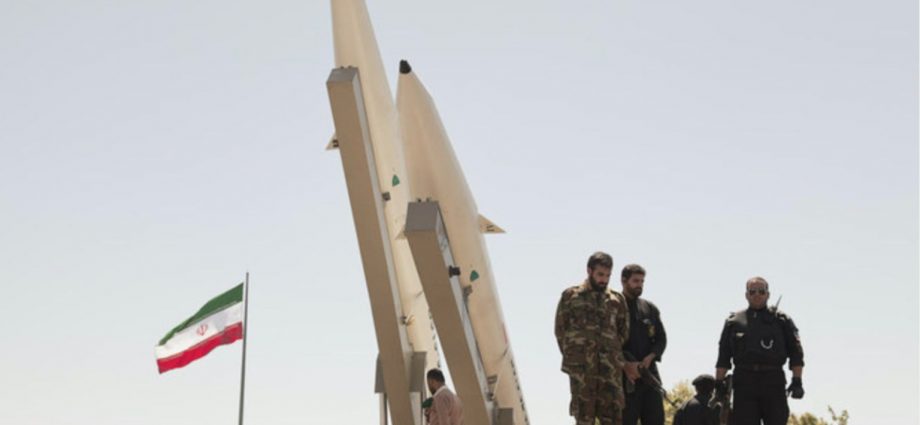Iran has unveiled a new type of air-launched cruise missile, known as the Asef, that aims to address accuracy shortfalls in its arsenal and increase its survivability and operational flexibility.
Last month, the Institute of International and Strategic Studies (IISS) reported that Iran had partially displayed the Asef on a Su-24M ground-attack aircraft and that it appeared similar to the Soviet-era Kh-55, which Russia has used in Syria and the ongoing Ukraine war.
IISS mentions that while Iran has been able to manufacture the Kh-55’s airframe, it has been unable to produce the missile’s turbofan engine, a complex piece of technology requiring substantial metallurgy knowledge and precision engineering.
IISS suggests Iran may have resorted to using a less-efficient domestic turbofan engine in a fixed configuration under the missile’s airframe rather than the drop-down engine layout of the Kh-55.
The IISS report says that the Su-24M’s 500-kilometer combat radius with the Asef’s possible 1,000-1,500-kilometer range gives the new missile a 2,000-kilometer maximum strike range, which if so would allow Iran to target all of Israel and most of Saudi Arabia.
The Kh-55 is the base design for numerous Iranian cruise missile models. As noted by Missile Threat in August 2021, the Kh-55 was first designed in 1971 as a strategic cruise missile capable of delivering a nuclear warhead at a range of 2,500 kilometers with a circular error probable (CEP) of 25 meters.
Missile Threat notes that the Kh-55 is roughly analogous to the US Tomahawk cruise missile, with a roughly identical body diameter and length and capable of carrying a 410-kilogram nuclear warhead or 400-kilogram conventional explosive warhead in the Kh-555 variant. Both are guided by inertial guidance or terrain contour matching (TERCOM).
Apart from the Asef, Iran has possibly made an entire family of cruise missiles based on the Kh-55 base design, including the Soumar, Hoveyzeh, and Abu Mahdi.

The Soumar, first unveiled in March 2015, is likely a ground-launched copy of the Kh-55, with a claimed range of 2,500 kilometers, as noted by Missile Threat in July 2021. However, the report notes that Iran’s inability to produce a domestic version of the Kh-55’s turbofan engine means that its range may be substantially less than Iran claims.
Further Missile Threat mentions that Iran unveiled the Hoveyzeh cruise missile in February 2019, which has a stated range of 1,350 kilometers, significantly less than the Soumar. Missile Threat also notes that Hoveyzeh’s engine housing is typical of a turbojet rather than a turbofan engine.
In August 2020, Iran unveiled a naval version of the Hoveyzeh known as the Abu Mahdi, which Iran claims has a range of 1,000 kilometers. However, it is unclear how the Abu Mahdi would manage midcourse guidance updates or why it has a shorter range than the Hoveyzeh, leading some analysts to suspect that it is the Hoveyzeh repurposed for anti-ship roles.
Iran’s cruise missile program may address the operational capability gap in its ballistic missile arsenal. As Asia Times reported last month, accuracy remains the primary limitation of Iran’s ballistic missile arsenal. Its missiles have limited capability against point targets, limiting their use against large targets such as cities and population centers.
However, J Matthew McInnis notes in a 2017 American Enterprise Institute report that Iran’s cruise missile arsenal has greater accuracy than its ballistic missile arsenal and more defensive and offensive operational flexibility.
Shahryar Pasandideh, in a September 2019 article in War on The Rocks, argues that Iran’s introduction of cruise missiles into its arsenal offsets the accuracy limitations of its ballistic missiles.
Iran’s cruise missiles increase the vulnerability of military facilities in the Persian Gulf region, as they are ideal for hitting point targets such as aircraft in hardened shelters. Pasandideh also notes that defense against cruise missiles is challenging, as their low-altitude, high-subsonic flight substantially reduces the reaction time of air defenses.
Moreover, Iran may be developing air-launched cruise missiles to improve the survivability of its missile arsenal. This month, The Intercept reported that the US has allocated secret spending for an Iran contingency plan (CONPLAN), codenamed “Support Sentry.”
Although the CONPLAN details are classified, the report notes that the US and Israel conducted their largest bilateral military exercise in January, dubbed Juniper Oak, which involved B-52s dropping bunker-buster bombs on simulated Iranian nuclear sites.
Besides ballistic and cruise missiles, Iran may be on its way to fielding hypersonic weapons. Asia Times reported in November 2022 that Iran may have already developed hypersonic missiles with Russian assistance as a quid pro quo for Iran’s provision of drones to Russia in the ongoing Ukraine war.

Russia already provides assistance to Iran’s medium-range ballistic missile (MRBM) program. However, there are no verified reports that Iran has ever tested a hypersonic weapon. Although Iran has a large domestic arms industry, it is known for exaggerating its military capabilities.
Furthermore, despite Iran’s push to achieve self-sufficiency and bypass sanctions imposed on its missile program, it still relies heavily on imported components. In a 2019 Foreign Policy report, Robert Einhorn and Vann H Van Diepen note that Iran still seeks essential missile parts and technologies from abroad.
The writers list these imports as guidance systems, ultra-high-strength steels and high-grade aluminum, ball bearings for liquid-fuel rocket engines, raw ingredients for composite materials such as carbon fiber, graphite parts for heat-resistant missile components, missile ground testing equipment and parts, and tungsten powder and alloy plates for thrust vectoring systems.

